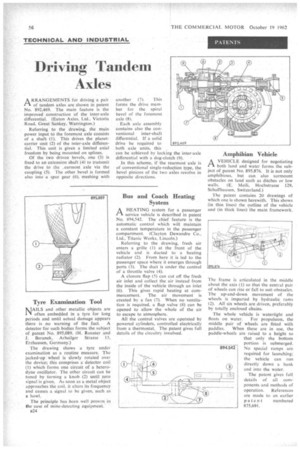Driving Tandem
Page 58

If you've noticed an error in this article please click here to report it so we can fix it.
Axles
ARRANGEMENTS for driving a pair of tandem axles are shown in patent No. 892,469. The main feature is the improved construction of the -inter-axle differential, (Eaton Axles. Ltd., Victoria :Road, Great Sankey, Warrington.)
Referring to the drawing, the main power input to the foremost axle consists of a shaft. (I). This drives the planetcarrier unit (2) of the inter-axle differential. This unit is given a limited axial freedom by being mounted on splines.
Of the two driven bevels, one (3) is fixed to an extension shaft (4) to transmit the drive to the .earmost axle via the coupling (5). The other bevel is formed also into a spur gear .(6), meshing with another (7). This forms the drive member for the spiral bevel of the foremost axle (8).
Each axle assembly contains also the conventional inter-shaft differential. If a solid drive be required to both axle units, this _ can be achieved by locking the inter-axle differential with a dog-clutch (9).
In this scheme, if the rearmost axle is of conventional single-reduction type, the bevel pinions of the two axles revolve in opposite directions.
Tyre Examination Tool
mAILS and other metallic objects are often embedded in a tyre for long periods and until actual damage appears
there is no warning of the fact. A detector for such bodies forms the subject of patent No, 895,089. (H. Rossner and J. Beranek, Arheilger Strasse 15, Erzhausen, Germany.)
The drawing shows a tyre under examination as a routine measure. The jacked-up wheel is slowly rotated over the device; this comprises a detector coil (1) which-forms one circuit of a heterodyne oscillator, The other circuit can be tuned by turning a knob (2) until zero signal is given7 As soon as a metal object approaches the coil, it alters its frequency and causes a signal to be given, such as a howl,
The principle has been well proven in the case of mine-detecting equipment. B24
Bus and Coach Heating System
AHEATING system for a passenger service vehicle is described in patent No, 894,542. The chief feature is the automatic control which will maintain a constant temperature in the passenger compartment. (Clayton Dewandre Co„ Ltd., Titanic Works, Lincoln.) Referring to the drawing, fresh air enters a grille (I) at the front of the vehicle and is ducted to a heating radiator (2). From here it is led to the passenger space where it emerges through ports (3). The duct is under the control of a throttle valve (4).
A closure flap (5) can cut off the fresh air inlet and collect the air instead from the inside of the vehicle through an inlet (6). This gives rapid heating at commencement. The air movement is created by a fan (7). When no ventilation is required, a flap valve (8) can be opened to allow the whole of the air to escape to atmosphere.
All the control valves are operated by powered cylinders, controlled electrically from a thermostat. The patent gives full details of the circuitry involved.
Amphibian Vehicle
A VEHICLE designed for negotiating
both land and water forms the subject of patent No. 895,876. It is not only amphibious, but can also surmount obstacles on land such as ditches or low walls. (E. Meili, Hochstrasse 129, Schaffhausen, Switzerland.) The patent contains 20 drawings of which one is shown herewith. This shows (in thin lines) the outline of the vehicle and (in thick lines) the main framework.
The frame is articulated in the middle about the axis (1) so that the central pair of wheels can rise or fall to suit obstacles. The up-and-down movement of the wheels is imparted by hydraulic rams (2). All six wheels are driven, preferably by totally enclosed chains.
The whole vehicle is watertight and floats on water. For propulsion, the middle pair of wheels are fitted with paddles. When these are in use, the paddle-wheels are raised to a height so that only the bottom portion is submerged. No special ramps are required for launching; the vehicle can run directly down a bank and into the water.
The patent gives full details of all components and methods of operation. References are made to an earlier patent numbered 875,691.




































































































































